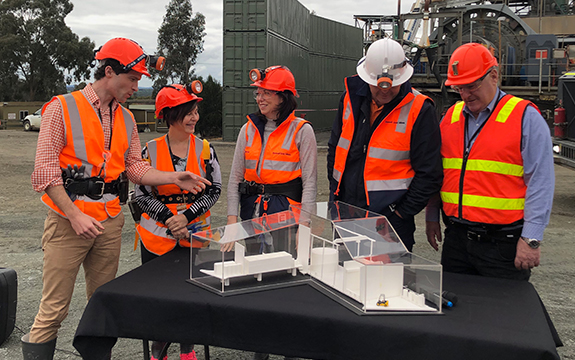Swinburne goes underground in search for dark matter

In Summary
- The Victorian state government has announced $5 million in funding to build the Stawell Underground Physics Laboratory to search for dark matter
- The Laboratory will host dark matter experiment SABRE, of which Swinburne is a core partner
- Swinburne is a founding member of the underground laboratory alongside project lead University of Melbourne and four other institutions.
Swinburne University of Technology will be a key institution in the international project to explore and search for dark matter, following an announcement that Victoria's state government will contribute $5 million to build the Stawell Underground Physics Laboratory.
The funding has been announced by Victoria’s state Minister for Regional Development, Jaclyn Symes, and matches the federal government’s funding commitment confirmed in April.
The laboratory will be built one kilometre underground, within the Stawell Gold Mine, as a bespoke excavated cavity 30 metres long, 10 metres wide and 10 metres high. It will provide ultra-low background research facilities (free from the particles that form background radiation) needed in the ground-breaking search for dark matter.
Swinburne is one of six international institutes involved in the project, led by the University of Melbourne.
The search for dark matter
Swinburne astrophysicist, Associate Professor Alan Duffy, says understanding dark matter is one of the greatest scientific challenges of this century.
“Astronomers have seen the movement of stars pulled by the gravity of an unseen companion. We now think that this unseen companion, dark matter, makes up five times more of the Universe than everything we can see combined,” he says.
“The attention of the world’s physicists will now be on regional Victoria as a leader in the search for dark matter.”
Associate Professor Duffy says that the establishment of Stawell as a physics research hub will also provide local education benefits.
“This Lab will undoubtedly inspire local students to study physics in school and at university, but it also means that if they want to be part of a global scientific experiment, they can do that right here in Stawell.”
The project is expected to deliver economic value to the region of $180.2 million in its first ten years, and support ongoing jobs.
Ms Symes says: “With nearly 80 ongoing jobs connected to the Lab, this project will diversify Stawell’s economy – attracting a new highly-skilled workforce to the region to live and work.”
University of Melbourne project leader, Professor Elisabetta Barberio, says the laboratory will be home to important scientific experiments.
“The investment by both the state and federal governments ensure the Lab is large enough to host dark matter experiments as well as everything from fundamental cancer research into how radiation affects cells growing, to creating new ultra-sensitive detectors and novel geological exploration techniques,” she says.
The project is a collaboration between six international partners. It will be led by the University of Melbourne alongside Swinburne, the University of Adelaide, the Australian National University, the Australian Nuclear Science and Technology Organisation (ANSTO) and the Italian National Institute for Nuclear Physics.
The first dark matter detector
Swinburne is heavily involved in building the largest experiment to take place in the Stawell Underground Physics Laboratory - SABRE (Sodium-iodide with Active Background Rejection), which is the Southern Hemisphere’s first dark matter detector.
The vessel will be arriving at Swinburne’s Wantirna campus in August, where it will undergo a rigorous assembly and electronics fit-out process, including leak testing and internal reflective surface coating. Only once the international team is satisfied that it meets the exacting standards for this kind of precision experiment will it move to the underground laboratory where the search for dark matter can begin.

